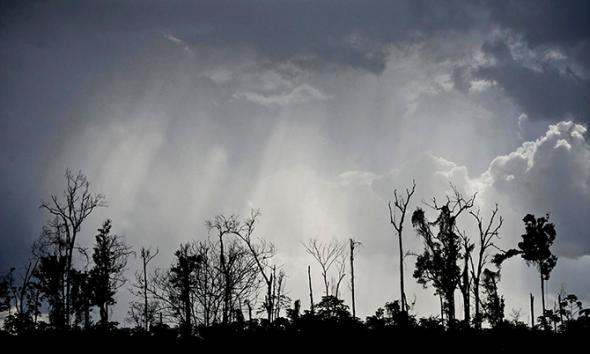As an environmental journalist, I start off each morning plowing through a half-dozen or so roundups of the day’s biggest environmental news. Invariably, it’s depressing and overwhelming; before I’ve even finished my first cup of shade-grown coffee, I’m barraged with stories of how climate change is ruining life as we know it and how zillions of animals are dying under our watch and how rapacious corporations and corrupt politicians are only making the situation worse.
All of this should make me fairly cynical about humankind’s penchant to protect the Earth. But I was nonetheless surprised that Gallup’s 2015 survey on the environment reveals Americans are less concerned about the environment now than at nearly any time in the past two decades. This optimism comes despite some seriously sobering news in the past year: The amount of carbon dioxide in the atmosphere reached an unprecedented 400 parts per million, for example, and a study in Nature concluded that we’ve ushered in the planet’s sixth great extinction, with 41 percent of all amphibians, 26 percent of mammal species, and 13 percent of birds facing extermination.
Given that hundreds of journalists, myself included, have dedicated our working lives to getting people to care about environmental calamities, does this mean we’ve failed?
Gallup analysts Jeffrey M. Jones and Rebecca Riffkin offer a few insights into why, despite our best efforts to convince them otherwise, Americans think the environment is looking pretty darn good.
- People are most worried about the most pressing threats: Across the board, people are more likely to care about air and water pollution than seemingly distant threats like climate change or the loss of tropical rainforests. This has been the case for decades.
- But more and more, environmental organizations are dedicating their efforts to those seemingly distant threats. Environmental journalists often follow suit, which means we’re losing touch with our audience. “The nature of the environmental agenda may indirectly be influencing Americans’ [degree of] concern,” writes Jones. That’s because “the primary focus of the environmental movement has shifted toward long-term threats like global warming—issues about which Americans tend to worry less.”
- The environment has become a politically polarizing issue. This isn’t shocking in and of itself, but the numbers are: Across six environmental issues measured from 2000 to 2015, the percentage of Republicans who worry “a great deal” is down an average of 20 percentage points. Looking at just one of those issues, climate change, 29 percent of Republicans considered it a big deal in the year 2000 while today just 13 percent do. Democrats are more worried now than they were 15 years ago, which means the gap between red and blue has grown even wider—and harder to bridge.
- Our view of the state of the environment depends on who’s in charge. The planet has only half as many living vertebrate animals now as it did in 1970. But a president like Barack Obama, who has strengthened the Clean Air Act and imposed other environmental safeguards, makes people believe that things are getting better while a less environmentally friendly president, like George W. Bush, leads Americans to despair. “From 2003 to 2009, an average of 41 percent said the quality of the environment was excellent or good, including an all-time low of 39 percent in 2009,” Riffkin writes. “Since then, coincident with the first full years of the Obama administration, the average has been 47 percent, similar to the levels recorded (during Clinton’s legacy) in 2001 and 2002.”
- The most recent poll shows that the number of Americans who consider the environment to be in “excellent” or “good” shape has jumped to a full 50 percent today—“the most positive views of the environment since Gallup began asking this question in 2001,” Riffkin writes. In fact, the number of Americans who care about global warming isn’t any higher than it was in 1989. So … did the message that melting ice sheets have passed a point of no return and coastal communities are being inundated just not get out? Or have we journalists made the state of the world out to be so god-awful that caring has become too much to bear?
Last month, researchers in the journal Nature Climate Change analyzed media coverage of the Intergovernmental Panel on Climate Change’s latest assessment and found that the answer might be the latter. The kind of depressing environmental reporting that dominates the news fuels a sense of hopelessness, the researchers found, which in turn causes disengagement. Or as one author puts it, the public is suffering from “climate story fatigue.”
At High Country News, the magazine I write for most often, we didn’t need a scientific study to tell us that stories offering a sense of hope are more popular than doom-and-gloom news. We’re working on a series called “Glass Half Full” that tells of innovative ways the American West is coping with drought, and we’re trying to include solutions as often as we write about problems.
But optimistic journalism can feel like sugarcoating. We want people to care, but we don’t want to obscure what’s really going on out there. If writers and editors want environmental journalism to remain relevant, we need to do a better job of striking a balance between the two.
